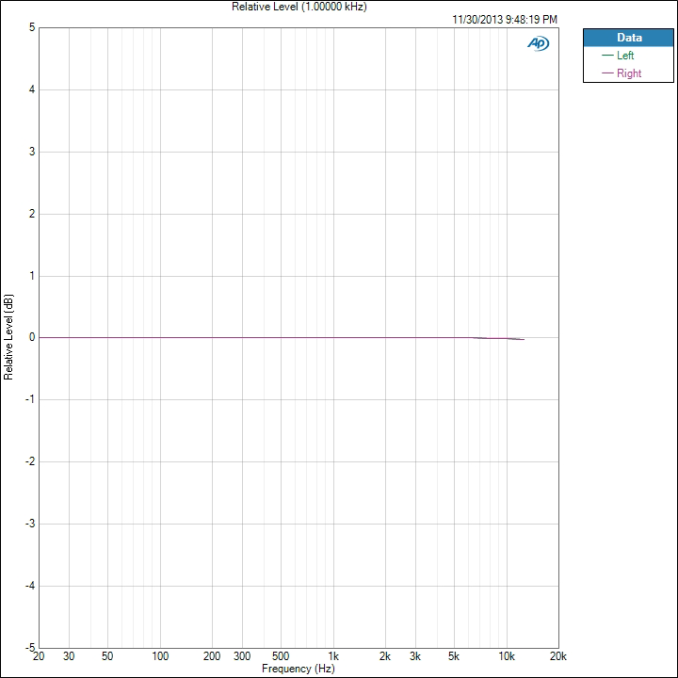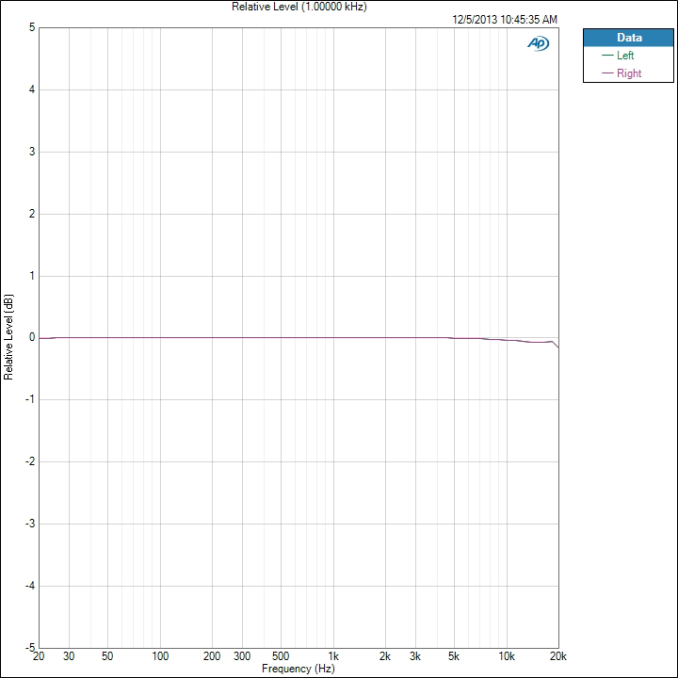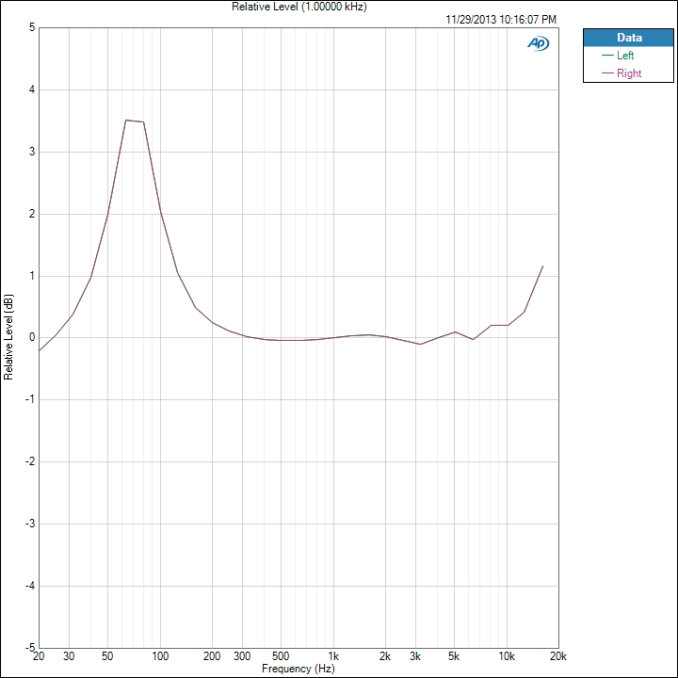Smartphone Audio Quality Testing
by Chris Heinonen on December 8, 2013 5:15 PM EST- Posted in
- Smartphones
- Audio
- Mobile
- Tablets
- Testing
Maximum Level
The maximum output level is derived from the 1kHz test tone used to determine THD+N. The higher the output from the headphone jack, the louder it can drive a pair of headphones. More importantly, having more power available means when you have dynamic music passages that call for power you are less likely to clip the waveform.
There is no chart to show here, just a number that the Audio Precision gives us. In our test data, the most powerful phone was the iPhone 5, at 32.46 mW of power. Next is the Nexus 5 at 22.24 mW, though we can’t drive it that high. Then the Note 3 at 11.81 mW and finally the Galaxy S4 at 3.895 mW. Doubling the power, from 4 mW to 8 mW, produces a 3 dB increase in volume level. 3 dB is the smallest change in volume levels we can easily hear. So even though the iPhone 5 produces 32 mW vs. 4 mW, that is only a 9 dB difference in volume. 10 dB is doubling the volume, so it isn’t even twice as loud. If you have demanding headphones, you will want as much power as you can get.
Frequency Response
To measure the frequency response we measure a set of 61 tones from 20 Hz to 20 kHz. All of these are then equalized to 1 kHz so we can see the maximum deviation from that level. An ideal phone will be perfectly flat here and allow you to adjust this with an EQ setting, or though your taste in headphones. On this test our best performing phone is the Galaxy S4, as seen here.
The total variation from 1 kHz is only 0.014 dB which is very good. The worst performing phone is the iPhone 5, but its variation is only 0.089 dB.
The iPhone 5 also picked up the 20 kHz tone while the Samsung and many others missed it. If we dropped this tone then it might be just as flat. The iPhone 5 test was run slightly differently, as it can't run the Android test program, which might account for this. For a phone with a different response, here is the HTC One with Beats enabled. Other HTC One testing is still in progress as I write this article.
Here we see that Beats is adding a +3.5 dB boost from 60 Hz to 90 Hz, but the deviation from 0 dB goes from 30Hz to 300 Hz. Past 6.5 kHz we also see a rise in the treble. People often mistake boosted treble for extra detail, which is likely the reasoning behind this. As we see it is far different than the other two examples we looked at.













188 Comments
View All Comments
JasonQG - Monday, December 9, 2013 - link
I'll be curious to see how the iPhone 5s compares to the iPhone 5. I noticed a definite improvement when I upgraded, at least to my ears' perception.ClockHound - Tuesday, December 10, 2013 - link
Nice to hear you're taking sound semi-seriously with devices that have a semi-important audio task. At least for those who use smartphones for aural communication and music playback.Nice to see the Audio Precision in action. Great unit. However, please, consider putting a little more thought into the scaling of your FR graphs. What appears visually as a huge peak in the htc Beats graph barely has a 3dB rise. That's not a huge peak.
A 1dB rise at 10k is not much of a rise and since it doesn't display enough data, we can't tell if it's a low Q event or not.
The Audio Precision can scale the vertical axis to make plots more informative rather than sensational.
pandemonium - Tuesday, December 10, 2013 - link
Awesome stuff. Keep it up AT!kreacher - Tuesday, December 10, 2013 - link
Great article, would it be possible to test audio input (the mic) in this much detail. Noise cancellation as well as how it does in speakerphone mode / video recording. I know earlier reviews / articles have mentioned this are but it would be great to have detailed numbers like this article.Cyleo - Tuesday, December 10, 2013 - link
This is awesome. I truly love this, please continue this work ;)Any change one of the more recent Sony models makes the test (Xperia z comes to mind)
Pastuch - Tuesday, December 10, 2013 - link
Chris, fantastic article, way to bring me back to Anand. Please include results of the Iphone 4s and any other phones you get your hands on. My girlfriend and I are phone whores, she's Apple, I'm Android. I'm constantly playing with all of our phones and cans trying to find the best audio combo.I run Sennheiser HD-25s, Sennheiser Momentums, V-Moda Crossfade M-80s, and Koss Porta Pros (Awesome since the 80s!).
Best sounding phone I've ever heard:
Iphone 4S sounds way better than the new Iphone 5. It's definitely louder and fuller. Too bad the 4s doesn't have APT-X codec for Bluetooth.
Runner up:
Samsung Galaxy S with Voodoo sound Rom (Note, you need to load a non-standard rom to make it sound great)
The rest:
SGS2 (International Model): Too quiet, poor quality, disappointing dynamic range.
SGS3 (North American Model): Poor quality, lots of cross talk, disappointing dynamic range.
HTC One (Beats Audio OFF): Sounds great, really no complaints. A step above most Android phones. Still miss the Wolfson DAC though.
IPhone 5: Still sounds great but it doesn't live up to the 4S. I'd say it sounds slightly better than the HTC One but the difference is really marginal.
Nexus 5: Sounds better than the SGS2 or 3. The V-Moda M80s sound good because they aren't hard to drive. The Sennheiser HD25 needs the top volumes and the clipping is obvious. The HTC One sounds a little better.
vision33r - Tuesday, December 10, 2013 - link
HTC One audio is a joke. Which features a software sound enhancer AKA Beats Audio which any custom rom can cook into their roms.I've had the S3 with the Beats Audio software and took it off flashed a better DAC amp app.
Traum - Tuesday, December 10, 2013 - link
As a head-fi audiophile, I want to THANK YOU for doing this!MWisBest - Tuesday, December 10, 2013 - link
Nice article, definitely curious as to how my Galaxy Nexus would fare in this, as I'm a bit of an audiophile.hrrmph - Wednesday, December 11, 2013 - link
Awesome topic and write-up :)Keep these coming, please.